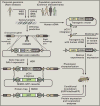Morgan's legacy: fruit flies and the functional annotation of conserved genes
- PMID: 26406362
- PMCID: PMC4783153
- DOI: 10.1016/j.cell.2015.09.009
Morgan's legacy: fruit flies and the functional annotation of conserved genes
Erratum in
- Cell. 2015 Oct 22;163(3):772
Abstract
In 1915, "The Mechanism of Mendelian Heredity" was published by four prominent Drosophila geneticists. They discovered that genes form linkage groups on chromosomes inherited in a Mendelian fashion and laid the genetic foundation that promoted Drosophila as a model organism. Flies continue to offer great opportunities, including studies in the field of functional genomics.
Copyright © 2015 Elsevier Inc. All rights reserved.
Figures

References
-
- Bridges CB. J Hered. 1935;26:60–64.
-
- Jan YN, Jan L. Science. 2008;319:45. - PubMed
-
- Lewis EB, Bacher F. Drosoph Inf Serv. 1968;43:193.
Publication types
MeSH terms
Grants and funding
LinkOut - more resources
Full Text Sources
Other Literature Sources
Molecular Biology Databases

